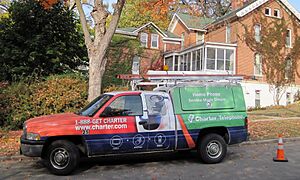Charter Communications facts for kids
 |
|
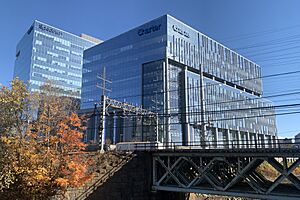
Headquarters of Charter Communications in Stamford, Connecticut
|
|
| Public | |
| Traded as | |
| Industry | Telecommunications Mass media (Internet) |
| Predecessors |
|
| Founded | 1993 in St. Louis, Missouri, U.S. |
| Founders |
|
| Headquarters |
,
U.S.
|
|
Area served
|
41 states |
|
Key people
|
|
| Products |
|
| Brands | Spectrum |
| Revenue | |
|
Operating income
|
|
| Total assets | |
| equity = ![]() US$19.71 billion (2024) | num_employees = 94,500 (2024)
US$19.71 billion (2024) | num_employees = 94,500 (2024)
| owners =
- Liberty Media (23.3%)
- Advance Publications (13%)
- Berkshire Hathaway (2.33%)
| website =
| module =
| Primary ASN | 7843 |
|---|
}}
Charter Communications, Inc. is a big American company that provides services like cable TV, internet, and phone. Its services are known by the brand name Spectrum. The company's main office is in Stamford, Connecticut.
As of 2022, Charter serves over 32 million customers in 41 states. It is the largest cable TV provider in the United States by the number of people who subscribe. It is also one of the biggest phone service providers. Spectrum services include fast internet access, internet security, and unified communications (which means different ways to communicate, like phone and video calls, all in one system).
In 2012, Charter moved its main office from St. Louis, Missouri, to Stamford, Connecticut. However, many of its operations still happen in St. Louis. In 2016, Charter bought two other large companies, Time Warner Cable and Bright House Networks. This made Charter the third-largest pay TV service in the U.S. In 2019, Charter was ranked number 70 on the Fortune 500 list of the biggest companies in the United States based on their total earnings.
Contents
- The Story of Charter Communications
- How It All Started: 1980–1992
- Becoming a Company: 1993
- Growing Bigger: 1994–1998
- Going Public and More Growth: 1999–2008
- Financial Challenges and Recovery: 2009
- New Leadership and Growth: 2010–2012
- Buying More Companies: 2013–2014
- Major Acquisitions: Time Warner Cable and Bright House Networks
- Recent Developments: Since 2017
- How Charter Works
- More About Charter
The Story of Charter Communications
How It All Started: 1980–1992
Charter Communications CATV systems was first started in 1980 by Charles H. Leonard in Michigan. The company's first offices were in Yankee Springs Township, Michigan. Charles Leonard later partnered with Gary Wilcox and Gerry Kazma. Their companies joined together in the early 1980s.
Becoming a Company: 1993
Through more mergers and buying other companies, Charter was officially formed in 1993. This happened thanks to Barry Babcock, Jerald Kent, and Howard Wood. They used to work for another cable company in St. Louis, Missouri. Charter Communications, Inc. was officially registered as a company in Missouri in 1993.
Growing Bigger: 1994–1998
In 1995, Charter spent about $300 million to gain control of cable TV systems owned by Crown Media Holdings. They also bought another company called Cable South.
In 1997, Charter teamed up with EarthLink, an internet company. Together, they started offering fast high-speed internet through cable modems to Charter's customers in California.
In 1998, Paul Allen, who co-founded Microsoft, bought a major share of Charter. The company also spent $2.8 billion to buy Marcus Cable, another cable company. By 1998, Charter Communications had one million customers.
Going Public and More Growth: 1999–2008
In November 1999, Charter Communications became a public company. This meant its shares could be bought and sold on the Nasdaq stock exchange. At that time, the company had 3.9 million customers.
Charter made more than 10 big purchases in 1999. These included:
- Adding 68,000 customers in Southern California.
- Acquiring 400,000 customers, mostly in the Southeast U.S.
- Merging with Marcus Cable.
- Buying cable systems that served 460,000 customers from other companies.
- Adding 173,000 customers in central Massachusetts.
- Acquiring Renaissance Media Group, which served 130,000 customers near New Orleans and other areas.
- Buying Helicon Cable Communications, which served 171,000 customers in eight states.
- Acquiring Avalon Cable TV, adding 260,000 customers in Michigan and Massachusetts.
- Buying Vista Broadband Communications, adding 30,000 customers.
- Acquiring Falcon Cable TV, which was the eighth-largest cable operator in the U.S. with about one million customers.
- Acquiring Fanch Communications Inc., which had 547,000 customers in several states.
Charter also started trading customers with other companies. This helped them group their systems closer together in certain areas. For example, in 1999, they planned to swap 1.3 million cable customers with AT&T Corporation in St. Louis and other states. In 2000, Charter bought some AT&T cable markets, including Reno, Nevada, and St. Louis.
In 2001, MSN and Charter agreed to offer MSN content and services to Charter's internet customers. Charter also received several awards that year for its growth and innovation.
In 2008, Charter bought the cable TV services for the Cerritos and Ventura, California, areas from Wave Broadband.
Financial Challenges and Recovery: 2009
In February 2009, Charter Communications announced that it planned to file for Chapter 11 bankruptcy. This process helps a company reorganize its finances and pay its debts. The company hoped this would reduce its debt by $8 billion and bring in $3 billion of new investments.
On November 30, 2009, Charter's bankruptcy plan was approved. This plan helped the company get rid of about $8 billion in debt. Charter successfully came out of bankruptcy that same day.
New Leadership and Growth: 2010–2012
On September 14, 2010, Charter's stock was listed again on the Nasdaq stock exchange under the symbol "CHTR".
In 2011, Paul Allen, the Microsoft co-founder, stepped down from his role as chairman of Charter's board. However, he remained the largest single shareholder at that time. Also in 2011, Charter made a deal with TiVo to deliver content using its platform.
Thomas M. Rutledge became a director and the president and chief executive officer of Charter on February 13, 2012.
That same year, Charter raised $1.25 billion by offering senior debt. This money was used to pay off some of its existing debts.
Buying More Companies: 2013–2014
On February 8, 2013, Charter announced it would buy some former Bresnan Communications systems from Cablevision. This deal was worth about US$1.63 billion. It brought Charter cable services to 375,000 customers in Colorado, Utah, Wyoming, and Montana.
About a month later, on March 19, 2013, Charter announced that Liberty Media would buy a 27.3% ownership share in the company. Liberty Media is controlled by John C. Malone, who used to be the CEO of TCI. This made Liberty Media the largest single shareholder in Charter. In November 2014, Liberty's shares in Charter were spun off into a new company called Liberty Broadband Corporation.
Major Acquisitions: Time Warner Cable and Bright House Networks
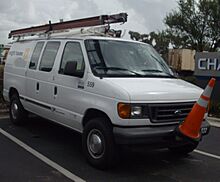
On January 13, 2014, Charter Communications showed interest in buying its bigger competitor, Time Warner Cable. Charter's CEO, Thomas Rutledge, wrote a letter to Time Warner Cable's CEO, Robert Marcus, suggesting they combine their companies. Time Warner Cable rejected Charter's offer.
On February 13, 2014, Time Warner Cable accepted a higher offer from Comcast, another large cable company.
However, in April 2015, Comcast decided not to go through with its merger with Time Warner Cable. This opened the door for Charter again.
On May 26, 2015, Charter and Time Warner Cable announced they had agreed to merge in a deal worth $78.7 billion. Charter also confirmed it would continue with its plan to buy Bright House Networks for $10.4 billion. The deal needed approval from government regulators. Many expected it to face less strict review than the Comcast/TWC deal because Charter and Time Warner Cable were smaller companies. After the merger, all the cable systems would be rebranded under the Spectrum name.
The merger was approved by the Department of Justice and the FCC on April 25, 2016. The approval came with certain rules. For example, Charter could not charge customers extra based on how much internet they used. It also had to expand its services to two million new households.
The merger was completed on May 18, 2016. This made Charter the third-largest pay television company in the United States.
Recent Developments: Since 2017
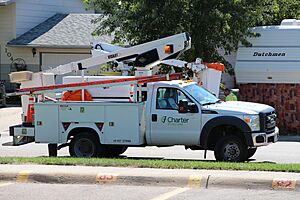
In January 2017, there were reports that Verizon Communications was thinking about buying Charter. However, Charter's largest shareholder, Liberty Media, said they were not interested in selling. The deal was rejected by the end of May 2017.
In March 2017, some of Charter's rules from the merger were changed. The company was now required to expand its services to 2 million households that did not have any broadband internet service. This change aimed to bring high-speed internet to more rural areas.
In May 2017, Charter and Comcast agreed to explore working together on wireless services. Both companies had deals with Verizon Wireless to resell its services. This agreement included a rule that they needed each other's permission before making any wireless-related purchases or mergers for one year.
In June 2017, it was reported that Charter was talking about buying Cox Communications.
On March 28, 2017, a union called IBEW Local 3 went on strike. This strike involved 1,800 employees. The union members were concerned about changes to their health and pension benefits. The strike ended on April 19, 2022.
In March 2018, it was reported that Softbank had bought 5% of Charter's stock.
New York State Issues
In June 2018, the New York Public Service Commission fined Charter $2 million. This was because Charter did not meet its promises to expand broadband service in New York after buying Time Warner Cable. The commission said Charter had made false statements in its reports. They even threatened to take away Charter's right to operate cable services in New York.
On July 27, 2018, the NYPSC voted to cancel its approval of Charter's purchase of Time Warner Cable. This meant Charter's right to operate in New York was taken away. The commission said Charter had repeatedly failed to meet deadlines and tried to avoid its promises to serve rural communities. Charter was told to make a plan to sell its New York operations, which served about 2 million customers.
Charter's CEO, Tom Rutledge, said the company would take legal action against the commission. However, Charter was later given more time to meet the requirements.
In April 2019, Charter agreed to new conditions. It had to finish expanding broadband to 145,000 new homes by September 30, 2021. All these homes had to be outside of New York City. Charter also had to contribute $12 million to a fund for broadband expansion projects.
New Streaming Plans
In April 2022, Charter and Comcast announced plans to work together on a new streaming platform. Comcast would share its Flex streaming platform and offer its XClass TVs and the Xumo streaming service.
Changes to TV Packages and a Dispute with Disney
In July 2023, Charter announced a big change to its cable TV offerings. Customers could now choose between a package with regional sports channels (Spectrum Select Plus) or a cheaper package without them (Spectrum Select Signature). Even the cheaper option would still include major sports networks like ESPN and FS1. This change came as many people were canceling their cable TV subscriptions.
At the same time, Charter made a new deal with DirecTV. This deal allowed DirecTV to offer more flexible options for customers who were not interested in sports programming.
On August 31, 2023, ESPN and other Disney channels became unavailable on Charter Spectrum. This happened during important sports events like college football and the US Open. Charter wanted to offer cheaper, non-sports packages to customers. The dispute ended on September 11, 2023. As part of the agreement, Disney agreed to offer ESPN+ and Disney+ directly to Spectrum customers. Some channels were also removed from Spectrum's lineup, including BabyTV, Disney Junior, Disney XD, Freeform, FXM, FXX, Nat Geo Wild and Nat Geo Mundo.
On November 13, 2024, Charter announced its plan to buy Liberty Broadband. Liberty Broadband was a company that held a large share of Charter. As part of this deal, Liberty Broadband would spin off its company GCI Communication Corp. to its own shareholders.
Proposed Merger with Cox Communications
On May 16, 2025, Charter announced its plan to merge with Cox Communications. The new combined company will be called Cox Communications. However, it will use Charter's Spectrum brand for its services to customers. In this deal, Charter will buy Cox Communications’ business services, like fiber internet and IT services. Cox Communications' parent company, Cox Enterprises, will contribute its residential cable business to Charter Holdings. After the merger, Chris Winfrey will continue as President & CEO. Alex Taylor will become the Chairman of the board, and Eric Zinterhofer will be the lead independent director. Cox Enterprises will own 23% of the combined company.
How Charter Works
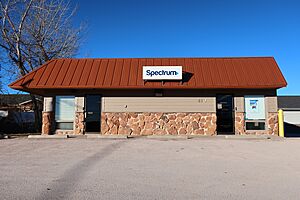
Current Operations
As of 2022, Charter Communications provides services to about 32 million people in 41 states. It has a lot of coverage in 38 of those states.
In November 2013, the company announced that it was rebranding its home services to Charter Spectrum. This included upgrading its network to be all-digital for video, voice, and internet services. The company mostly uses a network based on coaxial cable. However, it is also using newer fiber-optic systems. These fiber-optic systems provide much faster internet speeds than coaxial cables.
Larger businesses use Spectrum Enterprise for their services. These services include fiber internet, internet security, and phone and TV products. Spectrum Business offers services to small businesses. These include internet, internet security, phone, TV, and Spectrum Mobile for Business.
Spectrum also has an advertising part called Spectrum Reach. It offers advertising services in 36 states across 91 different media markets.
Past Operations
On March 27, 2006, Charter announced that it would sell some of its cable systems. These systems served about 43,000 customers in Nevada, Colorado, New Mexico, and Utah. They were sold to a company called Orange Broadband Holding Company.
Charter also sold cable systems in West Virginia and Virginia to Cebridge Connections. It sold systems in Kentucky and Illinois to New Wave Communications. However, Charter later returned to most of these areas (except Illinois) in 2016 when it bought Time Warner Cable.
On October 14, 2008, it was reported that Charter was selling parts of its system to Midcontinent Communications. This included Charter's offices in Bemidji and International Falls, Minnesota. Starting February 1, 2009, Midcontinent took over some of Charter's cable systems in Minnesota. Other areas in Minnesota were supposed to be sold to Comcast, but that deal did not happen.
On October 22, 2010, Charter sold 32 head-ends (main equipment locations) that served 65,000 customers. These were in Alabama, Arkansas, Georgia, Louisiana, Missouri, and Texas. They were sold to Cobridge Communications.
More About Charter
- List of United States telephone companies
- List of cable television companies
- List of Connecticut companies
- Spectrum Sports
- Spectrum News
- SportsNet LA



